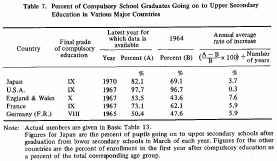| Home > Policy > White Paper, Notice, Announcement > White Paper > EDUCATIONAL STANDARDS IN JAPAN 1971 > CHAPTER |
||
In Japan the proportion of compulsory school graduates entering upper secondary schools recently went over 80%. This percent stands high in the world and is exceeded only by the U.S.A. On the other hand in European countries, the proportion of compulsory school graduates going on to educational institutions at the upper secondary school level still remains low, but the rate of increase in this proportion is much higher than Japan and the U.S.A. This due to the fact that in the European countries reforms are being made to expand secondary education.
In Japan the majority of students who enter upper secondary schools graduate. In the other major countries, however, a rather now percent or students at this level continue their studies until graduation. In the U.S.A. only 76% graduated from high schools in [968. In 1967, in England and Wales and France, 28% and 64%respectively of the upper secondary students continued their studies up to the age of seventeen. This is attributable not only to the existence of many dropouts but also to the fact that in European countries when pupils reach the maximum compulsory school age they can take various occupational qualifying examinations conducted by out-of-school organizations.
Next, attention is to be paid to part-time education at the upper secondary level in the major countries. Part-time educational institutions in the European countries in most cases correspond to the "miscellaneous schools" or to institutions other than regular schools in this country. They are in many cases under the supervision of government agencies other than the Ministry of Education. Thus, comparative study is difficult. Generally speaking, however, it may be said that part-time educational and training institutions for working youth are well organized in the European countries. The aims and types of these institutions are different from country to country, but in general. They provide mainly evening or part-time day courses one or two days a week so that working youths may improve their knowledge and skills and thus acquire qualifications needed in their occupations. Table 8 presents the enrollment percents of these part-time institutions. It can be seen that more than 70% of those who left school after compu1sory education attend either full-time or part-time educational institutions.

Note: Actual numbers are given in Basic Table 13. Basic Table 13 Figures for Japan are the percent of pupils going on to upper secondary schools after graduation from lower secondary schools in March of each year. Figures for the other countries are the percent of enrollment in the first year after compulsory education as a percent of the total corresponding age group.

Note: Actual numbers are given in Basic Table 14 Basic Table 14
| Back to Top | MEXT HOME |